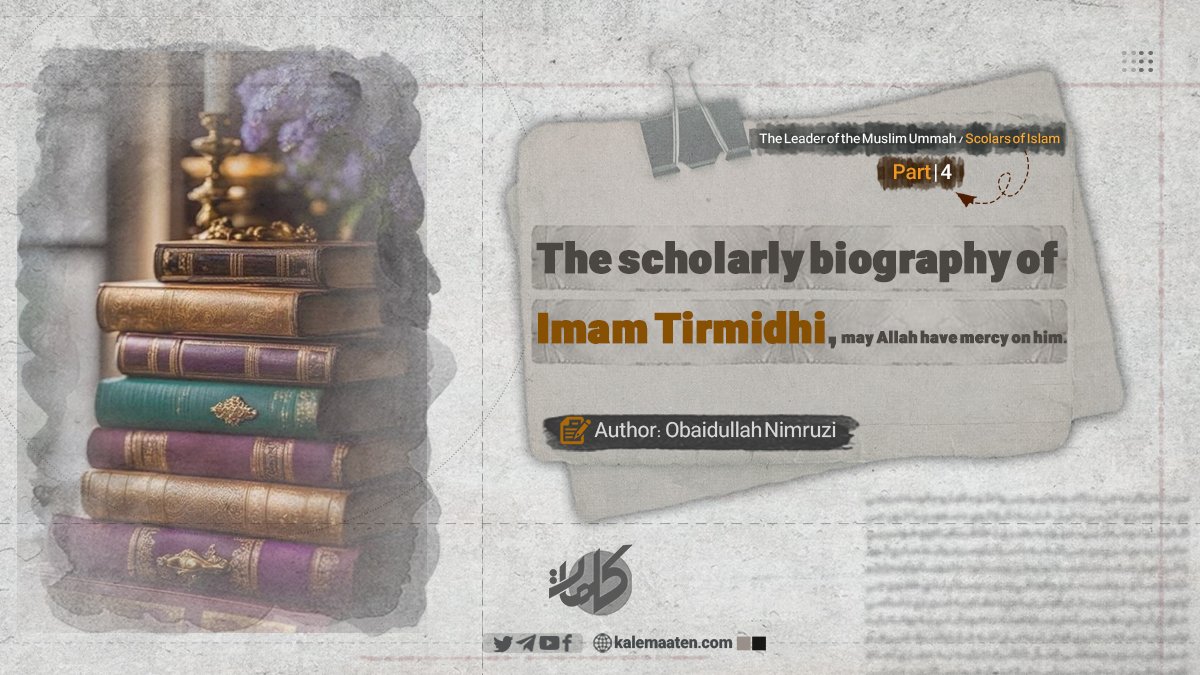
Author: Obaidullah Nimruzi
The Scholarly Biography of Imam Tirmidhi ‘May Allah Have Mercy on Him’ (Part 4)
Number of Hadiths in Jameh Al-Tirmidhi
Jameh Al-Tirmidhi contains 3,956 hadiths (without repetitions) that are compiled in the form of fifty main books and hundreds of sub-chapters. In addition to the Sunnah narrations, there is a section at the end of this book titled “Kitab Al-Illal,” which examines scientific topics; 58 prophetic hadiths are also included.
The Number of Chapters in Jameh Al-Tirmidhi
Mufti Muhammad Farid (may Allah have mercy on him) writes in his book about the number of chapters in Jameh Al-Tirmidhi: “The number of books in Jameh Al-Tirmidhi in the Indian versions is fifty books, referred to as ‘chapters,’ except for the book of ‘Al-Illal,’ which is called ‘Kitab.’ Additionally, the number of sub-chapters is 2,071, most of which are expressed by the word ‘Bab,’ while some are referred to as ‘Manaqib’ and ‘Faza’il.’ The number of chapters without translation is 225. Therefore, the total number of books and chapters in Jameh Al-Tirmidhi, both main and subsidiary, reaches 2,346 chapters.”
Chapters and Repeated Hadiths in Jameh Al-Tirmidhi
Mubarakpuri writes about the repeated chapters and hadiths in Jameh Al-Tirmidhi: “There are 10 chapters and 83 hadiths among the repeated hadiths in Jameh Al-Tirmidhi, all of which have been specified by the author of the introduction to Tuhfat al-Ahuzi.”
Common Hadiths in Jameh Al-Tirmidhi
Imam Tirmidhi mentions in his book Illal about common and unusual hadiths: «جمیع ما فی هذا الکتاب من الحدیث هو معمول به وبه اخذ بعض اهل العلم، ما خلا حدیثین: حدیث ابن عباس ان النبی صلیاللهعلیهوسلم جمع بین الظهر والعصر بالمدینة والمغرب والعشاء من غیر خوف ولا سفر ولا مطر، وحدیث النبی صلیاللهعلیهوسلم انه قال: اذا شرب الخمر فاجلدوه فان عاد فی الرابعة فاقتلوه»; “All the hadiths in this book, ‘Jameh Al-Tirmidhi,’ have been accepted, and some scholars have relied on them in their entirety, with the exception of two hadiths: 1. The hadith of Abdullah ibn Abbas regarding combining the Zuhr and Asr prayers, as well as the Maghrib and Isha prayers, without any excuse other than travel or fear. 2. The hadith of the Prophet (peace and blessings of Allah be upon him) who said: “If someone drinks wine, flog him; and if he drinks wine for the fourth time, kill him.”
Mawlana Taqi al-Din Nadwi Mazaheri discusses these two hadiths: “Some scholars have acted on these two hadiths. The Hanafi school of thought believes that the collection mentioned in the first hadith is a nominal collection and not a real collection. They also believe that the Muslim ruler can sentence a drunkard to death based on expediency.”
In the author’s opinion, this Hanafi view regarding the above hadiths may not have reached Imam Tirmidhi. Therefore, the ruling that Imam Tirmidhi issued concerning these hadiths is correct in its context, and Mazaheri’s opinion also seems logical.
Imam Tirmidhi’s Method in Narrating Hadith and Explaining Its Methods
Imam Tirmidhi followed the general method of hadith scholars in narrating hadith and mentioned the hadiths with their chains of transmission in his comprehensive book, Jameh Al-Tirmidhi. This method is commonly known in the terminology of hadith scholars as “extraction,” as the narration of the Musnad of the hadith specifies its source and reveals the method of narration.
Imam Tirmidhi was particularly careful in explaining the chain of transmission (Riwayat) of the hadith and fully fulfilled the rights pertaining to the chain of transmission. He employed four methods in narrating hadith:
1. Collecting multiple chains of transmission of a hadith in a single context.
2. Mentioning several chains of transmission of the hadith and stating the text only once, following the first chain of transmission.
3. Mentioning each chain of transmission of the hadith along with its text.
4. Mentioning one chain of transmission and referring to other chains of transmission.
Imam Tirmidhi’s Method in Collecting Chains of Transmission and Paying Attention to the Words of the Hadith:
A. Multiple Chains of Transmission of a Hadith in a Single Context
Imam Tirmidhi mentions all the chains of transmission of a hadith that have been narrated in different ways in his book Jameh Al-Tirmidhi and presents them in a single context. This method is employed when all the narrators are at the same level in terms of Jarh and Tahdil, and the narrations of the hadith are consistent in wording and meaning. This method is applied in Jameh Al-Tirmidhi in two ways:
1. Through the conjunction between the sheikhs:
In cases where a hadith is narrated from two or more sheikhs and their chains of transmission are united, Imam Tirmidhi introduces each of the sheikhs using the conjunction “and” and after mentioning the chain of transmission, presents the text of the hadith.
Example: In the Book of Fasting, in the chapter on what was said about the explanation of dawn, it is stated: «حدثنا هناد ویوسف بن عیسی قالا: حدثنا وکیع عن أبی هلال عن سوادة بن حنظلة -هو الشعیری- عن سمرة بن جندب قال: قال رسول الله صلیاللهعلیهوسلم: “لا یمنعنکم من سحورکم أذان بلال…”» “Hanad and Yusuf bin Isa told us: Waqi’ told us on the authority of Abu Hilal on the authority of Sawada bin Hanzala – he is Al-Sha’iri – on the authority of Samura bin Jundub, who said: The Messenger of Allah (may Allah bless him and grant him peace) said: ‘Do not let the call to prayer of Bilal prevent you from your sahar…’”
In this hadith, Imam Tirmidhi narrated it from his two sheikhs, Hanad and Yusuf ibn Isa, and stated the chain of transmission of each within the context.
2. Through the transfer between chains of transmission (Riwayat):
In this method, Imam Tirmidhi mentions the multiple chains of transmission of a hadith up to the point where they have elements in common and then begins the next chain of transmission by adding the symbol ” ح (H).”
Example: In the chapter on what has been narrated regarding the key to purification prayer: «حدثنا قتیبة وهناد ومحمود بن غیلان قالوا: حدثنا وکیع عن سفیان (ح) وحدثنا محمد بن بشار ثنا عبدالرحمن ثنا سفیان عن عبدالله بن محمد بن عقیل عن محمد بن الحنفیة عن علی عن النبی صلیاللهعلیهوسلم قال: “مفتاح الصلاة الطهور”. »
In this hadith, the chains of transmission from Sufyan onwards are linked together, and Imam Tirmidhi establishes a connection between the chains of transmission using the symbol “ح (H).”
Continues…


